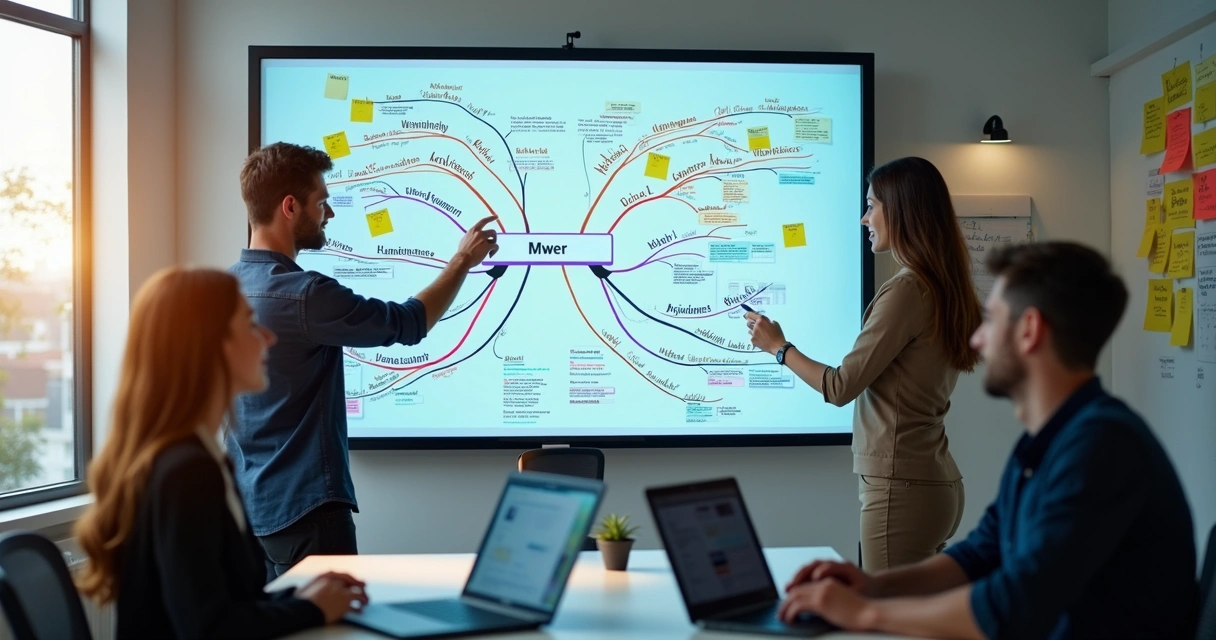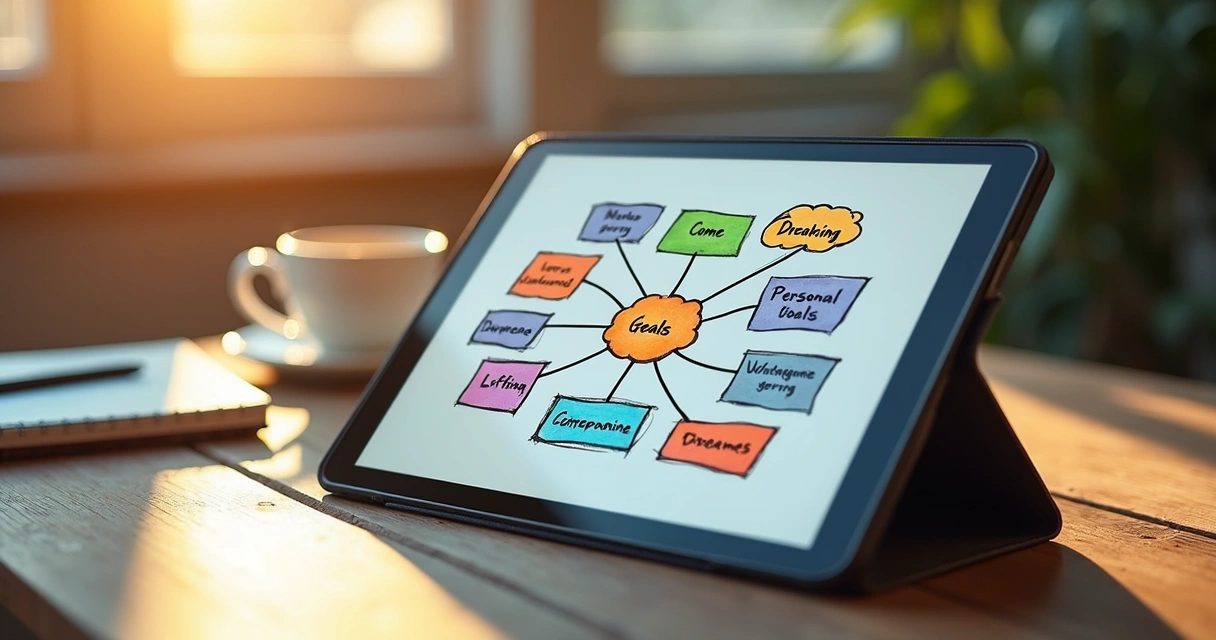
A Simple Guide To Visual Mind Maps For Organizing Ideas
Sometimes, one idea leads to another, and before you know it, your thoughts are scattered. You have sticky notes, lists, maybe voice memos. Still, it feels like a tangled mess. Is there a way to capture the flow of your thoughts as they naturally appear and connect them, all while keeping things simple and clear? Visual mapping might be the answer you've been missing.
What is a visual mind map? understanding the basics
A mind map, in its visual form, is more than a pretty diagram. It’s a practical tool. At its core, it starts with a central concept—sometimes just one word—written or drawn in the middle of a blank space. From this core idea, branches spread in all directions. Each branch represents a key theme or point connected to the main concept. Think of it a bit like the branches of a tree, each dividing further into smaller, more specific topics or ideas.
Unlike standard outlines or bulleted lists, this method is non-linear. That means your ideas can grow and connect in any direction. You end up with a web of related information that echoes the way most brains actually think. For many, this visual approach unlocks a better understanding and a more natural flow. In fact, about 65% of people are visual learners, and this technique can boost understanding and recall by 10-15%—which is nothing to ignore.
Ideas connect. Mind maps make those connections visible.
Why diagrams help: the science behind mapping
Your brain doesn’t work in long strings of text or perfectly organized columns. It jumps, leaps, comes back, builds connections and sometimes surprises you. Visual mapping suits this pattern perfectly, offering a platform for creative and critical thinking. It isn’t just theory, either. Research shows children’s word recall improves by up to 32% with this method, and long-term memory improves by about 10% for everyone.
Another study, quoted by several learning experts, links mapping with meaningful learning. New knowledge clicks into place better when you draw it out and literally see how it fits. In a classroom or work meeting, that’s a big difference.

Building a mind map: step-by-step
If you’ve never made one, starting can feel strange. But there’s a kind of gentle logic:
- Start with the core? Begin with your main idea or topic in the center of a blank page (digital or paper). Write it, draw it, highlight it. Make it stand out.
- Add main branches. Think about the biggest themes connected to your central idea. Draw lines or arrows outwards, label these with your key topics.
- Grow your branches. Each main theme can split into smaller branches. Add sub-ideas, examples, or related concepts here. Don’t worry about perfect order.
- Include images, colors, and symbols. The more visual, the better. Highlight ideas, use symbols for repeated points, draw little sketches. This isn’t just for fun—visual cues help memory and focus.
- Connect across branches. Sometimes an idea on one branch links perfectly with a different branch. Draw lines to show the relationship.
- Stop (or don’t). When it makes sense, stop. Or add more—expand whenever new thoughts connect.
Let your mind wander. Then follow it with your pen or mouse.
Manual or digital: which mapping style fits?
Many people start with paper and pens. The tactile feeling is hard to beat. It’s immediate and personal. But, there are some limits. Space runs out. You can’t move branches easily, and sharing with others isn't simple.
With digital mapping tools, you can add, move, or delete nodes anytime. Want to turn a branch into a main hub? Go ahead. Digital options such as NodeLand allow real-time editing, auto-organization, and collaborative mapping with friends or coworkers. You can also add files, links, and notes directly to any spot in your web. And if you work across devices—a laptop in the morning, tablet on the bus, phone later—it all syncs up. That’s hard to match with just paper and tape.

- Manual: Personal, creative, great for solo ideas, limited flexibility, hard to edit or share.
- Digital: Flexible, easy collaboration, real-time edits, can attach files and links, works well across devices.
Of course, it doesn't have to be one or the other. Many start on paper for a brainstorming session, then recreate or export their thoughts digitally for updates, sharing, or deeper organization. nodeland, for example, helps users convert handwritten or simple digital notes into interactive, flexible diagrams with ease.
Where mind mapping thrives: real-world examples
In education: learning by connection
Teachers and students have used diagrams for years to make lessons more meaningful. When learning history, for example, instead of listing key events, you might start with "World War II" and branch out to causes, timeline, leaders, major battles, and impacts. Each sub-topic further splits—like notable people, important dates, or underlying motives. This kind of structure isn’t just tidy. According to current research, recall and comprehension improve sharply, especially for visual learners and students with complex subjects.
Memory sticks when you can see the path your learning takes.
In business: making meetings and projects smoother
Meetings often go nowhere. People talk in circles. Tasks get missed. But drawing out the topics increases engagement. You can map out the main agenda items, then split into team tasks, deadlines, and follow-ups. Some companies use this during brainstorming or project planning sessions, making sure every relevant point is captured—no idea is too minor to branch out. It also simplifies tracking. Studies on project methodology show that visual organization increases learning and retention by up to 95% compared to traditional note taking. That’s jaw-dropping.
In personal knowledge management: tracking life, goals and projects
Maybe you’re organizing a move, planning a big trip, or just juggling life’s bits and pieces. Mapping lets you capture all the details: packing lists, timelines, important calls, things you can’t forget. Unlike a checklist, you see it all—how tasks connect and overlap, what needs attention, and where you’ve got freedom. For anyone balancing school, work, and personal life, this style of overview helps you avoid getting lost.

Choosing mapping software: what matters most
There's a lot behind a good digital mapping tool, though some features help more than others. Here’s a short list of things to look for:
- Intuitive interface: You shouldn’t need hours to learn the basics. Adding, deleting, and connecting nodes should feel natural.
- Integration: If you take notes in another app, or store docs in the cloud, make sure your tool connects easily—to avoid double work.
- Collaboration: Maybe you work in a team or need quick feedback from friends or teachers. Live editing and easy sharing are key.
- Access across devices: Ideas strike anywhere: on a walk, at your desk, or while commuting. Make sure you can open and edit maps on your phone, tablet, or computer.
- Visual cues and themes: Customization—like color-coding, icons, even images—can make the difference between a dry outline and an engaging map you’ll return to.
Platforms like NodeLand offer all these features, while allowing direct integration of AI assistants. This means you can get automated support for summarizing, branching, or reorganizing topics, as well as answers to quick questions along the way. It’s not about replacing your thinking—just supporting it as things grow more complicated.
Seeing is believing: connecting visualization and idea growth
Often, the hardest part of working on something new is simply starting. Looking at a blank page, it’s tough to know what comes first. Visual mapping gently lowers that barrier. You start in the center, add what comes to mind, and let your thoughts unfold. Color and structure are subtly reassuring. There’s permission to be messy and non-linear—sometimes, a great idea is just a branch away from the obvious.
Look at your ideas. The answers might be hiding in the lines you draw.
As you turn to these diagrams again and again, you might notice the web of your mind growing clearer. Reviewing branches or reorganizing topics allows for deeper understanding. It’s not magic, but it might feel like it after years of sticky notes and lost lists. As several studies confirm, this reflective process is much closer to the way our brains actually work. The results? More recall, better links between new and old knowledge, less forgotten information.
Conclusion: a better way to organize your mind
Visual mind maps are more than diagrams—they are living networks for your ideas. Whether you pick up pen and paper or open a sophisticated digital tool like NodeLand, you’ll be empowered to see your thoughts, not just list them. From boosting team meetings to making study sessions less confusing or simply tracking your life, this method has a quiet power. More people are learning that drawing their thinking out is almost like finding a shortcut through their own confusion.
If you’re ready to see your own thinking as it really is—organized, creative, open to change—start with a simple mind map. And if you want to take things even further, give NodeLand a look. Connect your notes, documents, and tasks; ask questions; see knowledge form right before your eyes.
Not sure where to start? Check out mind maps shared by the community for inspiration.
Frequently asked questions
What is a visual mind map?
A visual mind map is a diagram that starts with a central concept and expands outward using branches for related ideas and subtopics. This creates a map of information that reflects how thoughts connect and grow. The method uses colors, lines, and images to increase understanding and recall, and can be made on paper or digitally.
How do I create a mind map?
To make a mind map, put your main idea in the center of a blank page. Draw lines outward for each main topic connected to your idea, then keep breaking down those branches into smaller, more specific points. Use simple words, pictures, highlights, and make connections with lines between related ideas. You can do this by hand or with digital tools for more flexibility.
What are mind maps used for?
Mind maps are used to organize complex information, brainstorm ideas, plan projects, take notes, or visualize learning. They help with studying for exams, planning meetings, outlining essays, tracking personal projects, and more. Their visual structure helps you see patterns and remember details easily.
Are mind maps effective for studying?
Yes. Many studies show that mapping techniques improve learning and memory. They help students see connections, recall facts (by as much as 32% in some cases), and digest difficult concepts. Since many people learn best visually, mind mapping can turn studying from a routine task into something much more memorable and effective.
What tools can I use for mind mapping?
You can make a mind map with just paper and markers, but digital tools make adding, editing, and sharing maps much easier. Look for software with user-friendly interfaces, good integrations, options for collaboration, and mobile compatibility. Platforms like NodeLand bring these features together, letting you work across your devices and integrate AI support directly into your mapping process.